














































Menu
Harpsdale – Farming
The property known as Harpsdale was grazed upon by stock of early pastoralists as early as 1836, and the brodie family took ownership of that area from 1864 to 1906. Harpsdale then went through a succession of owners to 1941, which also included a Soldier Settlement called Troodos.
In 1941 Harpsdale was purchased by Jock Simmie and has been farmed continuously ever since. Jock Simmie established a successful Dorset Horn Stud but his son John moved towards Merino sheep and mixed farming after Jock’s death in 1968. In turn, John’s son Richard continued the family tradition on the property, albeit at a smaller scale. In 2026, Harpsdale will be acquired by a large property developer, thus ending 85 years of Simmie possession.

(R J Simmie Collection)
1836
Brothers Richard and George Brodie hold Bulla-Bulla and Deep Creek pastoral runs
1849
Brodie brothers lease crown land and also purchase land in Yuroke area, called ‘Dunhelen’
1864
First mention of ‘Harpsdale’ farm as Brodie’s property
1873
David Brodie and family move to Harpsdale
The leadlight Brodie coat-of-arms, still in a window at the homestead.

(R J Simmie Collection)
The original stone wall at the entrance to the home paddock.

(R J Simmie Collection)
Hay scythes and hand-pushed furrows from the earliest days of Harpsdale

(R J Simmie Collection)
1875
Architect John Augustus Bernard Koch wins tender to build Harpsdale homestead – it was among his earliest commissions.
Koch was born in Hamburg in August 1845 and migrated to Australia with his family in 1855. He was educated and trained as an architect in Melbourne and served his articles with F M White. He became White's assistant until 1873 when he started his own practice. In 1871 he married Anna Puttmann at the German Lutheran Trinity Church at Eastern Hill (East Melbourne) where they were active members of the congregation. They had a family of six sons and three daughters. In 1873 he was appointed as Architect to the City of Melbourne and designed a number of market buildings. In 1887 he was appointed Architect for the City of Richmond. He took an active interest in professional and community affairs. He was active in the RVIA, served as a Councillor in the City of Richmond for eight years and served as Mayor from 1882 to 1883.
Koch ceased practice in 1913 and his fifth son, Bernard, carried on his practice. He died in Hawthorn, Victoria in August 1928. He is buried in Boroondara Cemetery.
His best known buildings are the National Trust owned Labassa (originally called Ontario) (1889-1890) in Manor Grove, Caulfield North and the privately owned Friesia (1887) at 23 Isabella Grove, Hawthorn. Most of his work was in Hawthorn and Richmond.
1883
J A B Koch wins tender to build brick stabling at Harpsdale and possible additions to the homestead.
The original stable, along with a grinding wheel from the 19th C.

(R J Simmie Collection)

(R J Simmie Collection)
1904
Harpsdale sold, several owners to 1940.
Auctioneers Handbill, 1921

(R J Simmie Collection)
This machine is a Benyal’s Improved Chaff Cutter from Heybridge Co, Maldon, England. It dates from the end of the 19th/beginning 20th century. Originally, it was on the first floor of the original stables, sitting above the chute you can see behind it in this photo. When Richard Simmie renovated the upstairs, the upstairs floor had to be replaced because of wood borer. The space between the floor upstairs and the ceiling below (lined with ceiling boards) was full of chaff dust from all the years of making chaff.
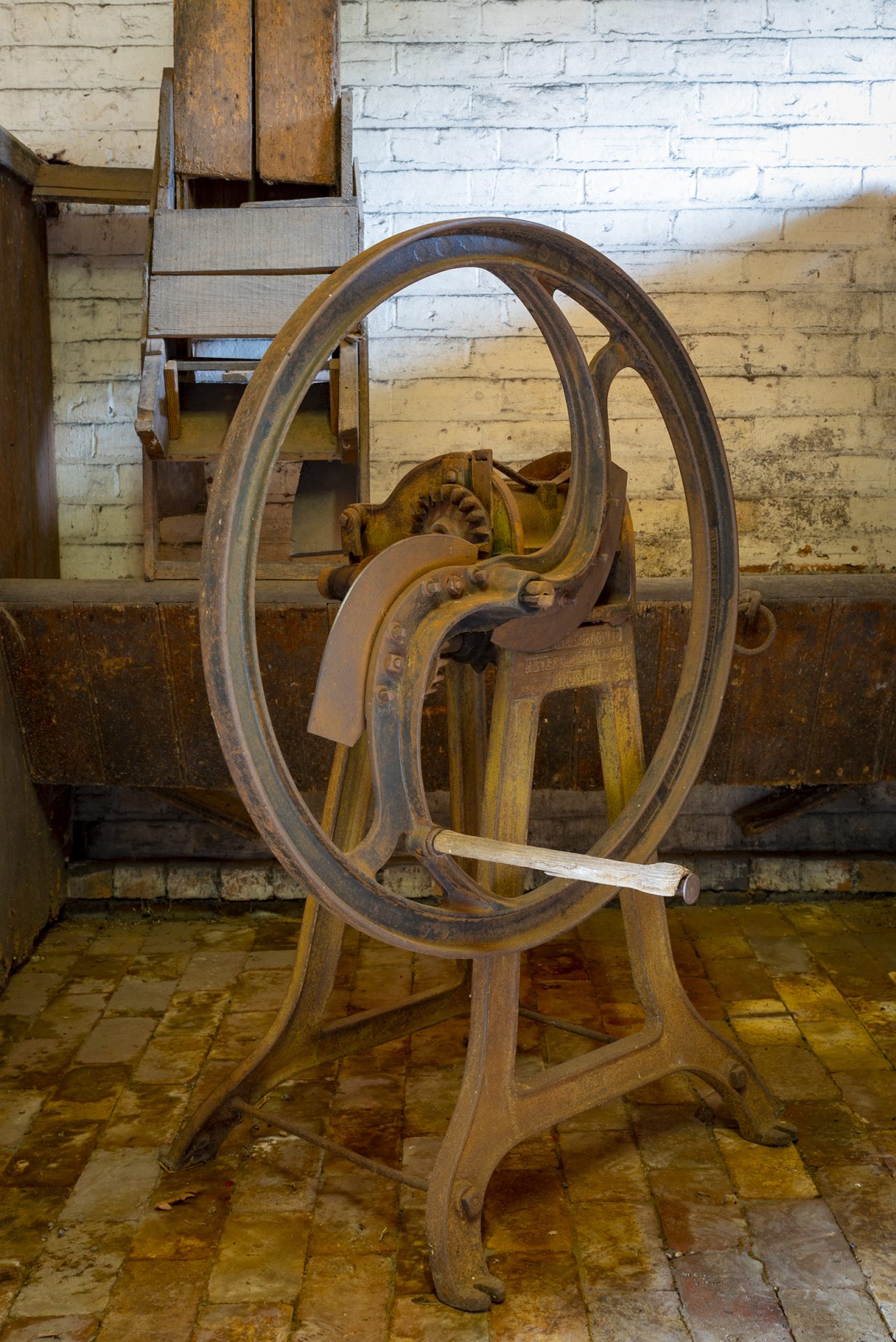
(R J Simmie Collection)
1905
David Brodie dies
1921
Soldier Settlement established on Harpsdale land – became known as ‘Troodos’.
In May 1919, Stanley Gordon Lording, an employee of Arthur Chesney Wilson of Harpsdale, applied to the Closer Settlement Board for a Qualification Certificate. Lording had served with the 4th Field Artillery Brigade, for 3 years, partly as a gunner in France, and was discharged in May 1919 as medically unfit having been gassed. He provided a reference from a farmer who wrote that he had ‘known the bearer S. G. Lording for a number of years, and can recommend his as being capable of managing any farm work he might be asked to do on a farm both dairying or agricultural work’.
At the time of his application, Lording was married with one child. His wife owned a cottage, and a few acres. The application for 200 acres at Mickleham for mixed farming went through under his own name. Lording had to wait until January 1921 before he could legally occupy the land.
An assessment of the suitability of the land for farming made in December 1919 reported that the country was gently undulating, with grey loamy and black soil, metal roads. 110 acres was cultivated to oats and 80% of the land was deemed cultivable. The water supply was a dam and tank, rainfall being typically 23 to 25 inches. The land’s carrying capacity was deemed to be 2½ or 3½ sheep per acre but there was no knowledge of how many cows could be kept for dairying. The land was best suited for oats, perhaps dairying with rape, millet and maize. Some timber on the land was Box but chiefly Gum suitable for buildings and fencing. There were 30 to 80 head of cattle on the property, later called ‘Troodos’.
1928
Arthur Kirke Dyson-Holland leases ‘Troodos’
Dyson-Holland was born in Tasmania in 1894. In 1914, Arthur enlisted in World War One in Queensland, where he was working at a station overseer, in June 1917. He served in France before returning to Australia in 1919, the same year his mother remarried to William Edward Brock Macleod, Macleod being the partner in Macarthur and Macleod stock agents.
Dyson-Holland applied to lease the [Soldier Settlement land at Harpsdale] but asked for a revaluation of the land price. A Board revaluation took place in late 1927 where the valuer increased the value of the best 100 acres from £13 per acre to £13-10, reduced the value of the other 100 acres of ‘stony and crab-holey’ land down from £10-10 per acre to £9-10 (total of £2,300) and, with the improvements of £517, the whole property was valued at £2,817.

Harvesting at Harpsdale January 1929
(R J Simmie Collection)
(R J Simmie Collection)

Harvesting at Harpsdale 1929 with a Robinson header
(R J Simmie Collection)
(R J Simmie Collection)
Arthur Kirke Dyson Holland was aged 33, single, and while his stepfather William Macleod had agreed to furnish him with assets and act as guarantee for his endeavour, he requested the Board assist him in making improvements. While stating he currently had no occupation, he had 17 years of experience on the land and referred to himself as a station manager. He intended to use the land for cropping and grazing stock, was prepared to make his home at the house but asked the Board to erect two additional rooms for use as a kitchen and a bathroom and install three additional water tanks to ensure he had an adequate water supply.
1933
Troodos
An annual return for June 1933 shows Dyson-Holland had harvested 106 tons of hay, 46 of which he used on the farm for horses and cows. Of the remainder he figured he would need to use some for fallowing and cows. He sold oat straw for £25, £23 of which were spent on superphosphate for the crops. His oat crop yielded 100 bags of cleaned grain half of which he held for seed, the remainder he sold. The chaff cutting cost him £19 for 46 tons.
His wheat crop produced 100 bags, of which he sold 42, 35 of which earned £14 which he used to pay part of the £44 owing for harvesting and thrashing wages. The remaining seven bags were used to pay the chaff cutter his wages. Eighteen bags of wheat were kept for sowing a ‘shandy’ crop, 12 were sown for grain, and 10 were kept for fowl feed. In November 1933 he sold 20 tons of his hay for a total of £52-10 but had to include £2-10 of his own money to send the total amount he owed the Commission.
1940
Jock Simmie purchases ‘Harpsdale’, near Craigieburn north-east of Melbourne.

Plan of Harpsdale Estate Mickleham
(National Archives of Australia Record)
(National Archives of Australia Record)
1941
Arthur Kirke Dyson-Holland made manager at Harpsdale.
Harpsdale Dorset Horn Stud 768 established at Harpsdale.
1942
Jock Simmie’s son, John Ernest (Red Jack) starts work at Harpsdale

(R J Simmie Collection)
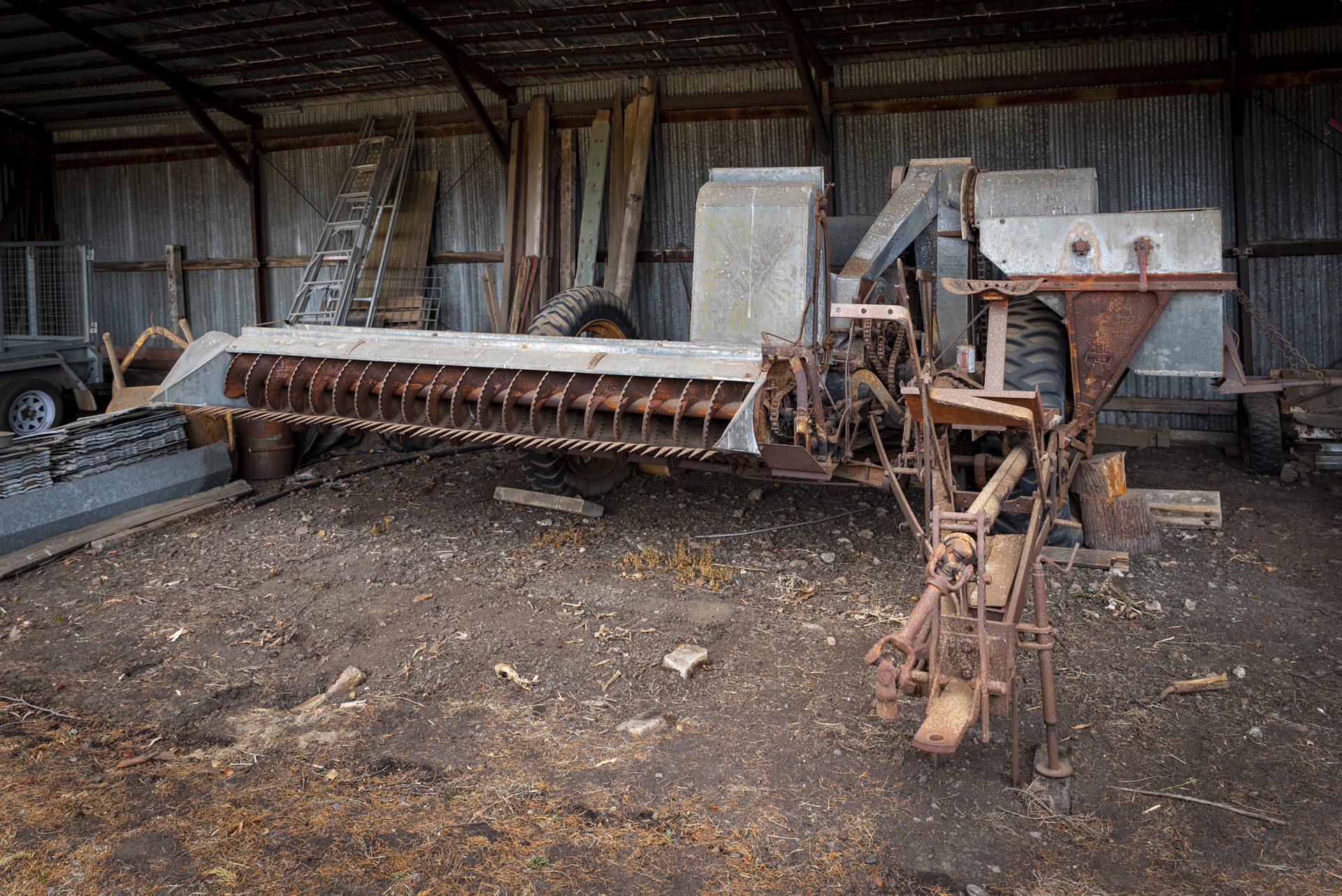
(R J Simmie Collection)
1943
Purchased Sunnie Light
This machine in the garden under the golden cypress near the machine sheds at Harpsdale is a 3 furrow tractor type ‘Sunnie Light’ set disc plough purchased from H V McKay Massey Harris Pty Ltd, Sunshine. Purchased on 8th June 1943 for £37.

(R J Simmie Collection)

(R J Simmie Collection)
1944
Title to Harpsdale to Jock Simmie

The new disc plough that replaced the old 3 disc plough from 1943.
(R J Simmie Collection)
(R J Simmie Collection)
1948
MacKay Massey Harris 30K HV tractor purchased for Harpsdale

Dipping sheep at Harpsdale , pre-1952 - caption
John Simmie on the left, Jean, on the right with probably A Dyson-Holland or William McAuliffe, the farm hand. Ivy in the background.
(R J Simmie Collection)
(R J Simmie Collection)

The drenching tool, shown in use in the image above.
(R J Simmie Collection)
(R J Simmie Collection)
1949
Harpsdale wins first prize at Newmarket sales from the Australian Society of Breeders of British Sheep for a pen of five Dorset Horn rams.

Arthur Dyson-Holland with prize-winning Dorset Horn rams at Newmarket Sales, Melbourne 1949
(R J Simmie Collection)
(R J Simmie Collection)
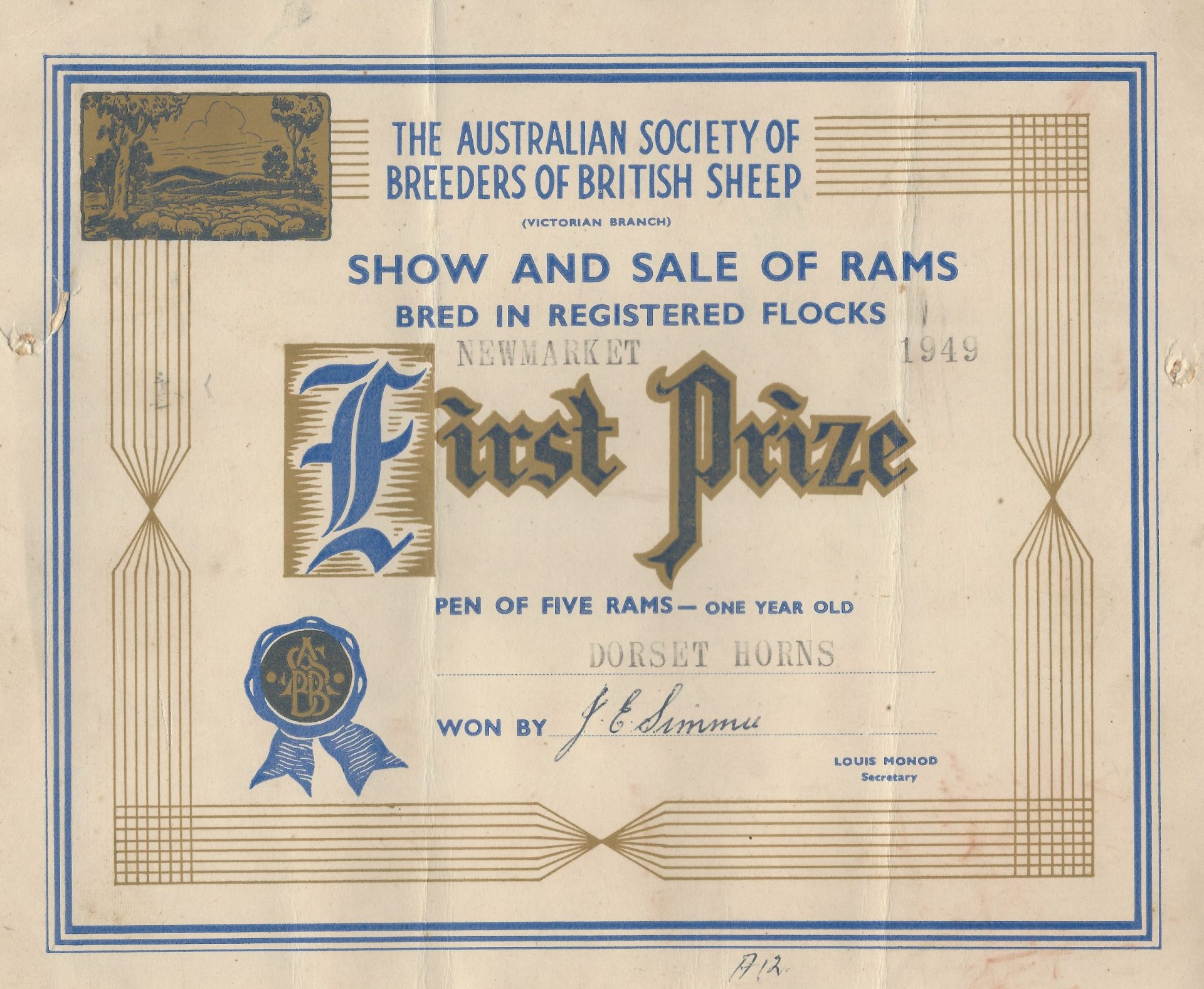
First Prize certificate, Dorset Horns, Newmarket 1949 to J E Simmie
(R J Simmie Collection)
(R J Simmie Collection)
Jock Simmie’s son, John Ernest, marries Jean Gamble and move to ‘Belmont’
1950
Jock Simmie pays world record price of 510 guineas for the ram ‘Newbold’ at the SA Newbold Sales
In January 1951, the agricultural magazine The Australian Farm and Home wrote about the Harpsdale Dorsets. In particular, at the October 1950 Newbold Sales in South Australia, Jock Simmie paid the world breed record price of 510 guineas for the ram Newbold 162 of 1949.
This purchase represented another step in the progress of a stud which may well be challenging older Victoria studs for supremacy in the next year or two. In nine years, by consistent use of Newbold sires and capable handling of the flock by his manager, Mr. A. Dyson-Holland, Mr. Simmie has built up a very fine stud…..Harpsdale has been developed into an almost pure Newbold blood flock. The breeding flock at Harpsdale now comprises about 300 ewes…The stud has always marked more than 100% of lambs.

The 510 guineas Dorset Horn ram bought by Harpsdale at the Newbold Sales, South Australia 1950
(R J Simmie Collection)
(R J Simmie Collection)

Dorsets at Harpsdale, homestead in background c1950
(R J Simmie Collection)
(R J Simmie Collection)
The smaller seed & fertilizer drill which was newer and tractor drawn. It does not have a brand name on it and dates from the late 1940's/early 1950s. It may have been bought at the same time as the header/harvester but there are no records of this.

(R J Simmie Collection)
1952
H V McKay Massey Harris ‘Sunlifter’ Bale Loader, purchased for Harpsdale in 1952.

(R J Simmie Collection)

(R J Simmie Collection)
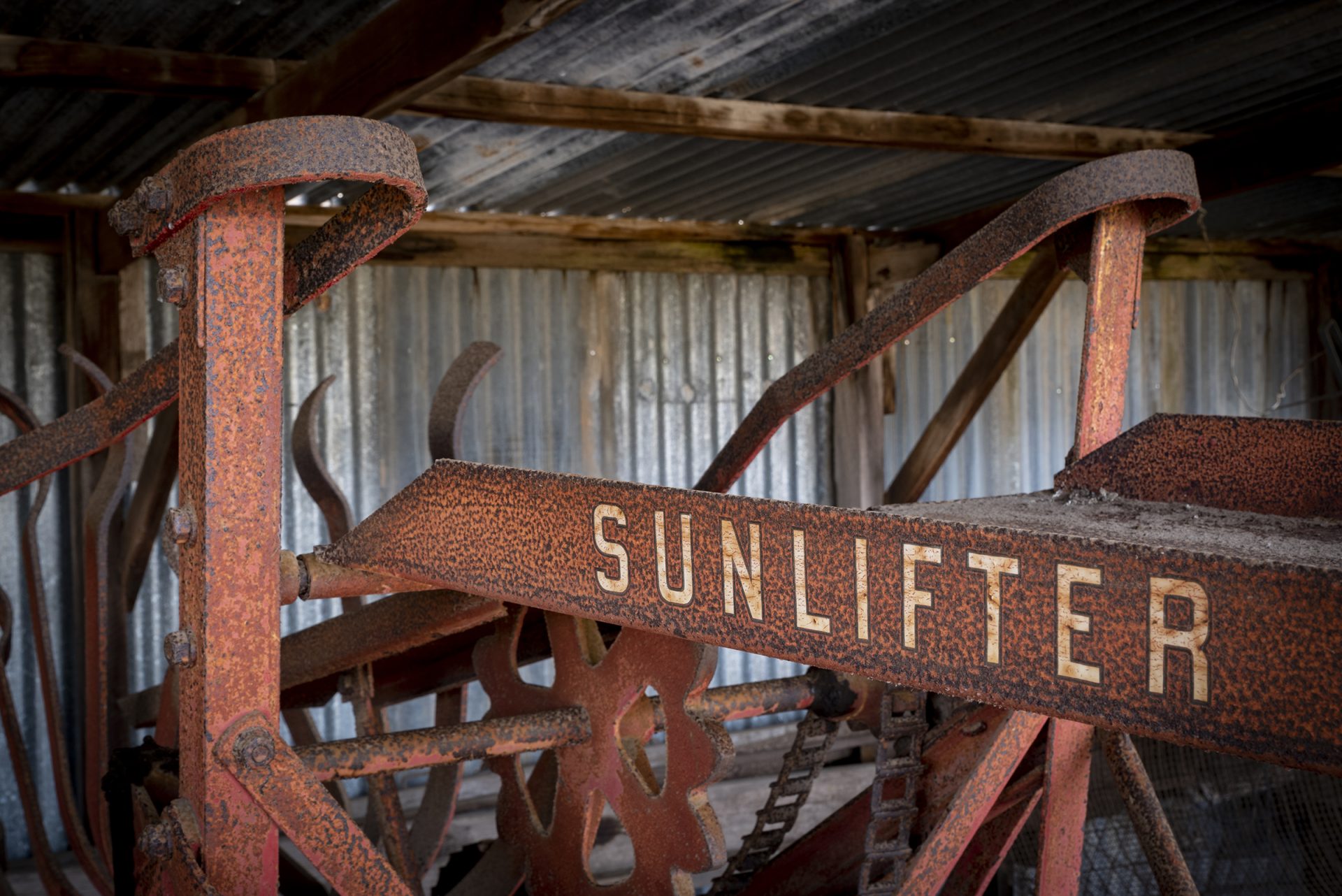
(R J Simmie Collection)
The Sunshine Number 6 header/harvester with power take off (PTO) dates from 1952. The shed that was built to house the new header/harvester.

(R J Simmie Collection)
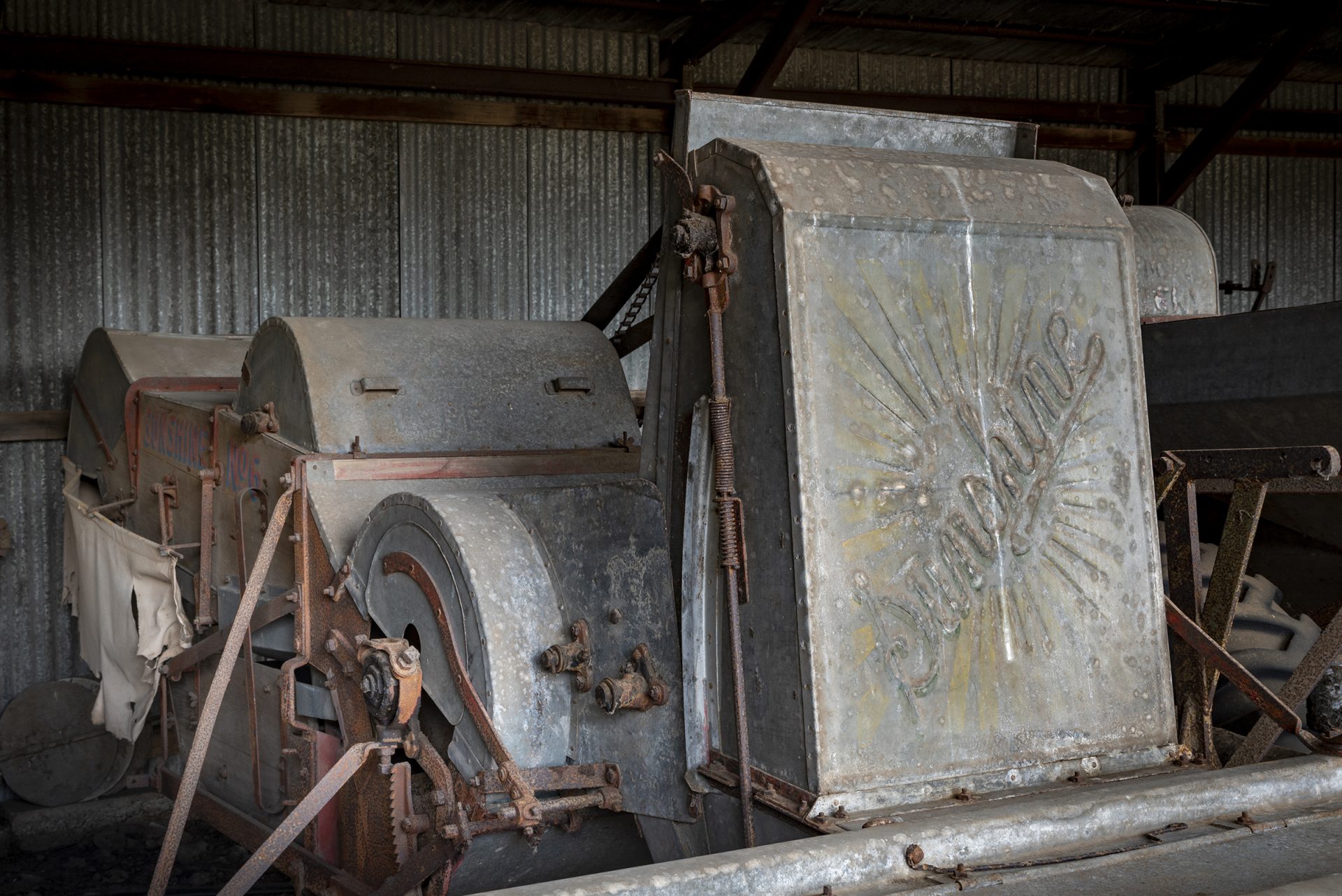
(R J Simmie Collection)

(R J Simmie Collection)
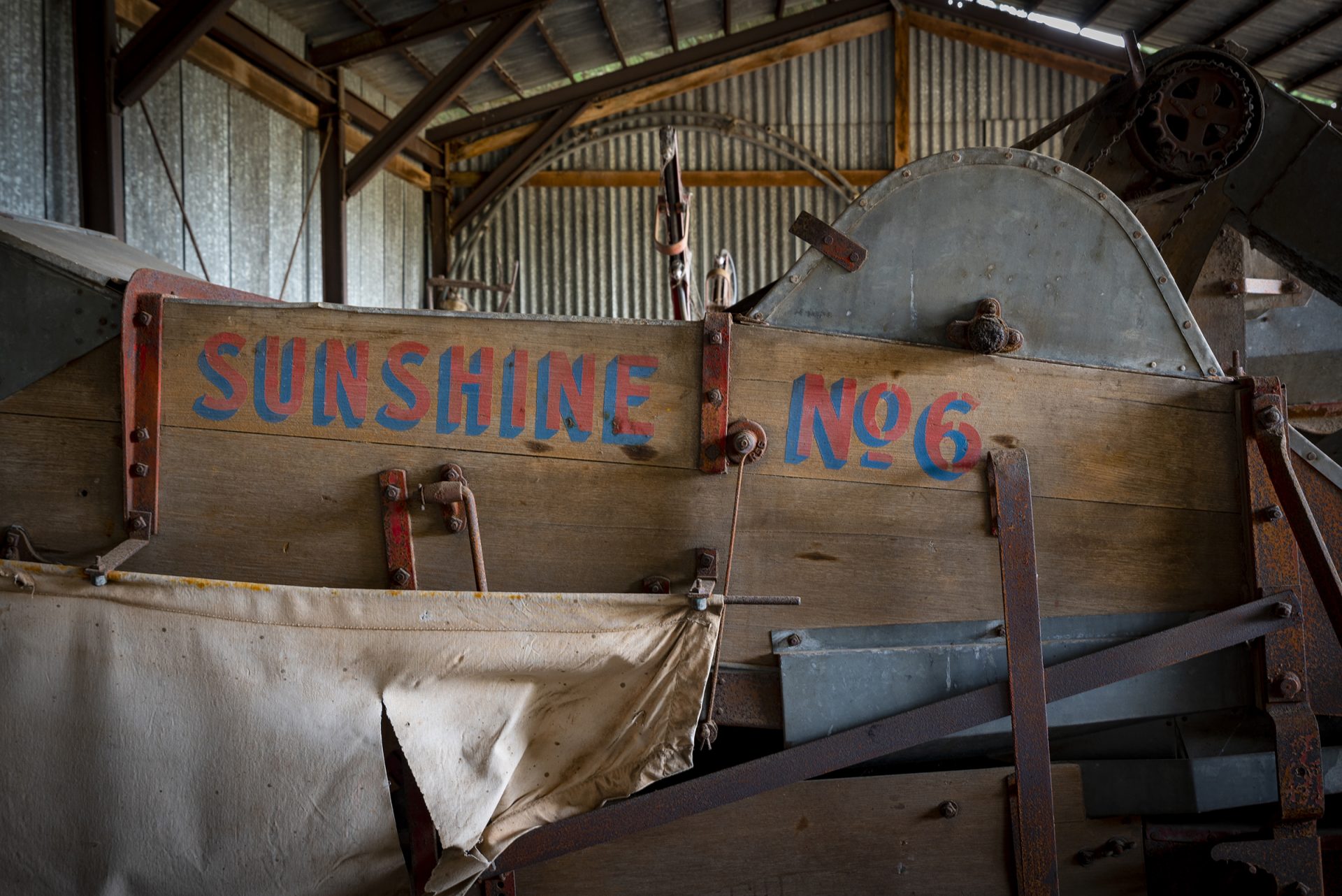
(R J Simmie Collection)
1955
Dyson-Holland’s ‘Troodos’ paid off with Jock Simmie’s help
The inspector’s assessment on the allotment of July 1942 seemed more upbeat, with a report that it was a ‘good prospect’, Dyson-Holland was a ‘good settler’ who had 300 ewes at present lambing. In September 1946 however, there was no stock, it being out on agistment, no plant and 270 fowls on the land. Dyson-Holland was still working as manager for Harpsdale. The stock were frequently ‘on agistment’ over the next few years, during which time he remained employed by Simmie.
Then, with little explanation as to the source of the funds, Dyson-Holland sent the Board a cheque for £778-5-3 on 30 March 1955, this being the balance owing on the property. The Board of Land and Works approved the issue of a Crown Grant for the land in June. The grant was issued on 16 June 1955, and Troodos once more became privately-owned land. Jock Simmie’s interest in purchasing the land remained, not least to ‘re-unite’ Troodos with the rest of Harpsdale, but that would take another decade, the death of Dyson-Holland and a Supreme Court case.
This old dray (remains) was used to cart hay through to the early 1950s.

(R J Simmie Collection)

(R J Simmie Collection)
1957
Remains of the new dray, mid-1950s
This dray was given pneumatic tyres from a WW2 fighter plane. Post-war austerity or farmer innovation?

(R J Simmie Collection)
New Shearing Shed built at Harpsdale

Shearing shed and yards (put in by Richard Simmie in 2012) in 2023.
(R J Simmie Collection)
(R J Simmie Collection)
1960
The Newbold Sales in South Australia
The annual Newbold sales were the largest stud sales in Australia, held at the Newbold Sheep Stud near Gawler in South Australia.

Jock Simmie sits on right with pipe in mouth, as usual.
(R J Simmie Collection)
(R J Simmie Collection)
1962
The New Holland Engine Functioned Model 68 Hayliner, pick-up baler, serial number A690D003 was purchased on 28 May 1962 from Whittlesea Farm Suppliers, for £1,389.
The hay baler at Harpsdale was fitted with a motor attached to it. There was an option to have direct PTO drive or this. It was easier to move around. Towing this by tractor was slow and also dirty work with the dust etc.
John Simmie did the hay baling for his brothers-in-law at Greenvale (Bill Gamble), and further north up old Sydney Road, Ted & Joyce Gamble, at their property called ‘Cooinda’. That was where Jock Simmie purchased extra land of 470 acres which was to be his daughter Joyce’s inheritance.

New Holland Hayliner 68
(R J Simmie Collection)
(R J Simmie Collection)
1963
Arthur Dyson-Holland dies, 18 October 1963
1964
Jock Simmie buys 477 acres next to Ted and Joyce Gambles’ farm – intended as Joyce (Simmie’s) inheritance
1965
Title of ‘Troodos’ to Jock Simmie
1967
Drought years at Harpsdale 1967-68

Rabbit traps, the essential tool to reduce competition by pests for water and feed during drought.
(R J Simmie Collection)
(R J Simmie Collection)
1968
Jock Simmie dies 13 August 1968, in Essendon
1970
John and Jean Simmie move into ‘Harpsdale’ from ‘Belmont’
1971
Peter Simmie marries Robyn Abbey; they move into ‘Troodos’

Top priced Dorset Horn ram and equal top ram at the SA Dorset Fair.
J E Simmie (L) with co-buyer W Martin (centre) and breeder L Hart (R)
(Stock and Land 1971)
J E Simmie (L) with co-buyer W Martin (centre) and breeder L Hart (R)
(Stock and Land 1971)
1972 - 1973
Peter Simmie and family move from ‘Troodos’ into ‘Belmont’, Harpsdale.
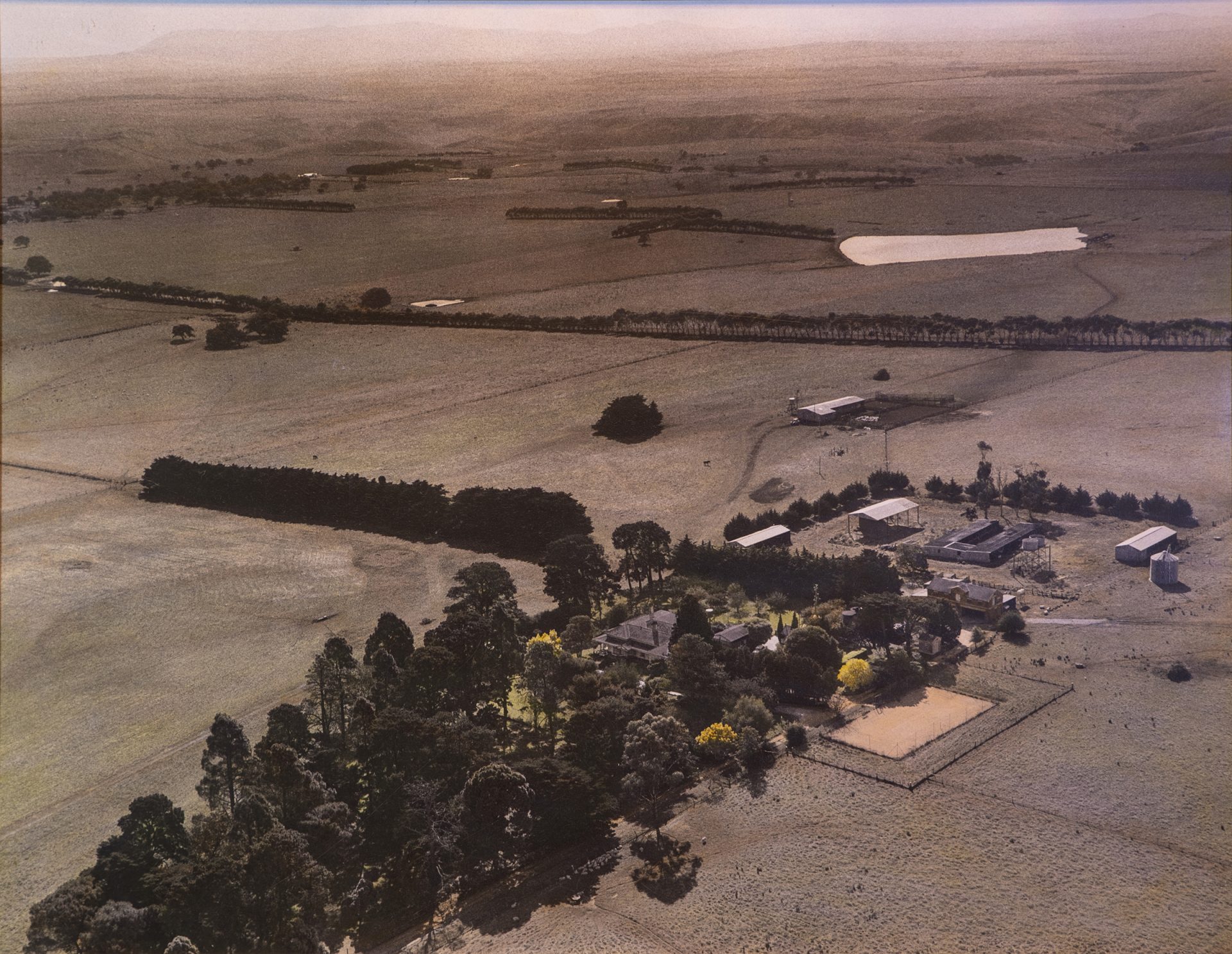
(R J Simmie Collection)

(R J Simmie Collection)
These aerial photo was taken in April 1973. A person called in to see John Simmie one day and marketed his product of taking such photos. He had a small plan which he used. The photo on the left was coloured to reflect the Autumn.
A modern day von Guerard, the 19th C artist who made a living out of painting pastoral properties around the state!
Still the same woolshed but showing the original yards, dating from 1957. Note the tennis court and no workshop.
Harpsdale 2019

(R J Simmie Collection)
This photo taken in 2019 from a similar perspective shows the tennis court gone, the smaller yards installed by Richard Simmie in 2012, and the success of the plantation in left rear planted by Richard Simmie. in order to get Primary Production status on the 200 acres of Harpsdale that would ultimately be his, he entered a contract with Woollybutt P/L to establish a tree plantation over 70 acres consisting of sugar, spotted and red iron bark gums, radiata pine and river sheoaks:
I liked the idea of reforesting the very bare and stark landscape that I had grown up with. The early settlers were ruthless in how much they cleared. I was able to get a grant from the State Government to get a formal proposal. It is a very long-term investment, 30 plus years and I will not see the benefit of what I have had done but still take pleasure and pride in all the carbon that has been stored since its inception.
The ‘Sun’ seed & fertilizer drill which was horse drawn and belonged to a neighbour to the east, Reginald Poole. Poole did a lot of contacting for Jock Simmie such as pasture sowing etc. It was Reginald’s father, William, who owned ‘Belmont’ which Jock bought in 1941 along with Harpsdale. The equipment would date from the 1930s.

(R J Simmie Collection)
John Simmie bought it at the clearing sale when Reg. died in 1973. He wanted some parts from it for his own seed & fertilizer drill, then parked the equipment under some cypress trees where it sat until Richard Simmie rescued it and put it in the shed after John Simmie died in 2012.

(R J Simmie Collection)
1974
December – a major storm blows through causing much damage to the homestead, infrastructure and trees.
1981 - 1982
Tractor purchase
A Case tractor was purchased in 1982 (manufactured in 1980). John Simmie borrowed money from his great aunt to buy it. She was Ivy Simmie’s younger sister by 12 years.
This David Brown/Case 1390 tractor with Challenge Fork Lift was purchased in March 1981 at a cost of $16, 266. The trade-in was a Nuffield 460 dating from 1969.

(R J Simmie Collection)
1986
John Simmie winds down the Harpsdale Dorset Horn Stud established by Jock Simmie

Wool sorting circa 1986 - black caption
J E Simmie (right) , Unidentified worker (left)
(R J Simmie Collection)
(R J Simmie Collection)
‘Click Go the Shears’ Stamp first issue July 1986.
The photographs were taken at Harpsdale
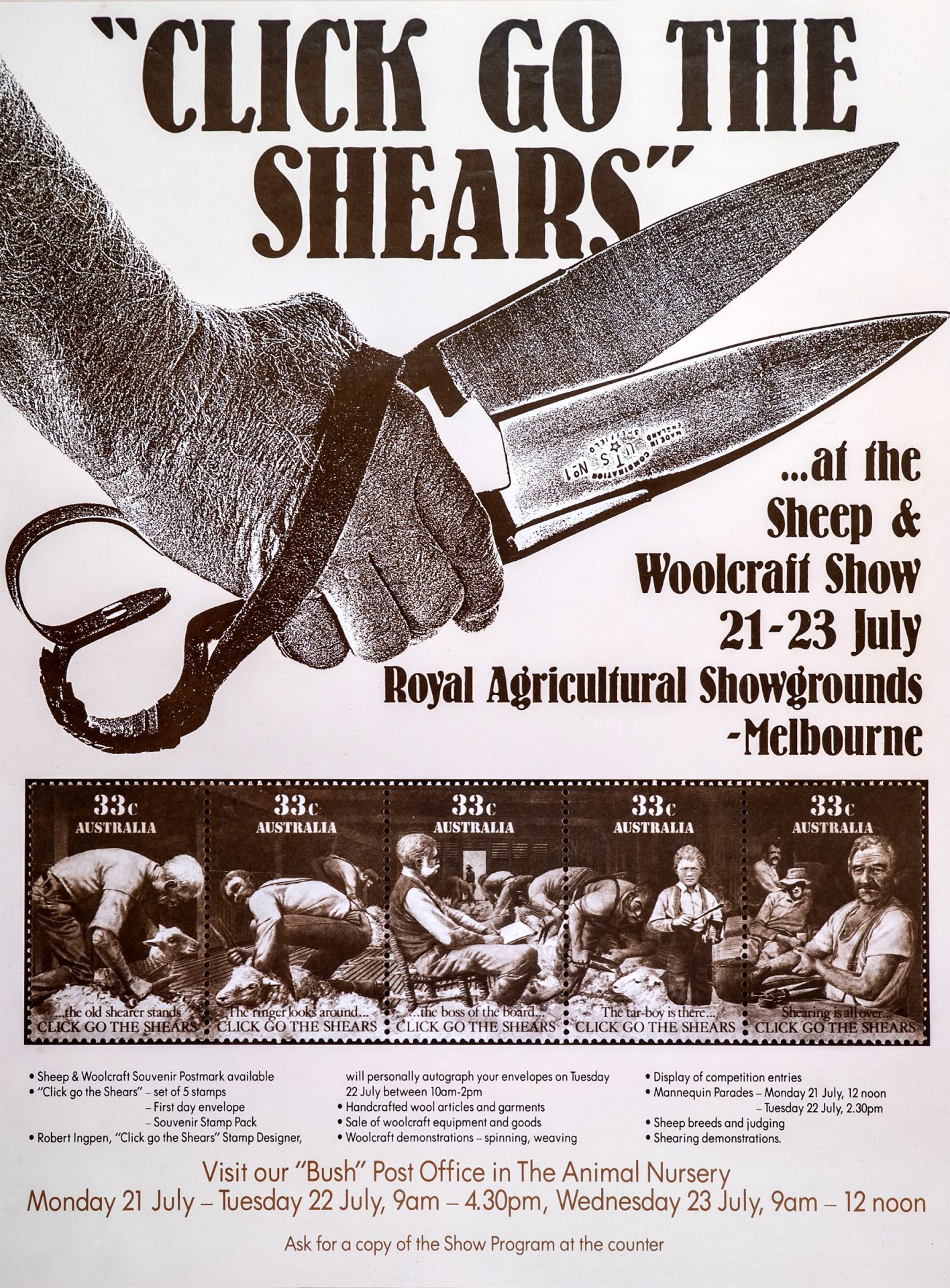
(R J Simmie Collection)

(R J Simmie Collection)
John Simmie with with sheep dog 'Sam' c1992

(R J Simmie Collection)
1996
Peter Simmie leases 'Belmont' and establishes vineyard
1990 - 2000
Decade of drought
A snapshot of some Harpsdale farm records show the following entries, reflective of the tough business of farming during the nineties:
1990 - High number deaths. Wet summer Feb rains. Wool rot, big fly problem. No jetting done. Pip, working dog died cancer 17.2.90. Wool co-op buying most wool at floor (860 clean). Fed Gov. drops floor price to 700 clean.
1992 - Very wet spring (92) & summer. Wool rot, very bad fly problems. Bad worm problems. Could not get jetting done. 455 died in 3 months, Jan to 1st week April 1993. Never had worse conditions.
1994 - Indifferent year. Spring below normal rain, Autumn rain below average. June – stock in strong shorn condition.
1995 - 66 killed by dogs. Fed wheat 6 months. Drought broke in May, 95, to end of May. No feed, too cold for growth. No sunshine.
1996 - 80 sheep killed by dogs. Benara ewes with foot rot (clover Belmont paddock wet spring in 95). Late break from drought, turned cold, no feed. Wet late autumn into winter, paddocks turned to mud by stock. Cold, no sun or drying stock.
1997 - Drought still feeding every second day. Benara foot rot. Couple of Benaras got through fence.
1998/1999 - Still drought. Stopped feeding as I reduced number & a little spring rain produced enough feed. Still no run of water. About 6 ft of water left. 7 sheep killed by dogs. 15 Nouranies short at shearing, stolen, same as last year. They were in ‘Quell’ paddock both times prior to shearing. Back boundary Mt Ridley Road. No run of water for nearly 2 years.
1998

Undated media image, 1990s, ‘Recent Elders Clip of the Sale winner John Simmie, second from right, presented a high-quality consignment of 21.5-micron wool from his Harpsdale property at Yuroke. At right is John Nichol of Elders Kilmore and at left Elders technical officers based in Lara, Bob Plane and Bernie O’Brien
(R J Simmie Collection)
(R J Simmie Collection)
2001
John Simmie retires
Belmont, Harpsdale, and land in trust for Peter, Philip and Richard Simmie
Richard contracts Woollybutt P/L to establish tree plantation at Harpsdale
2007
Richard Simmie purchases small herd of Black Angus weaners, maintains small mob of meat sheep.
Black Angus at Harpsdale
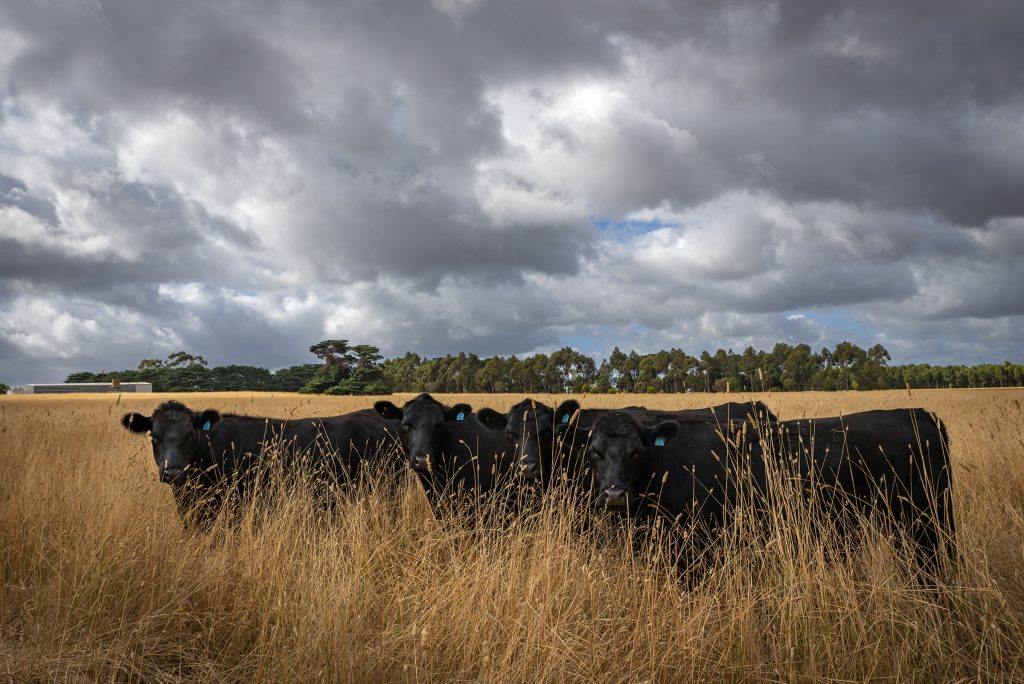
(R J Simmie Collection)
2008
Last vintage at Peter Simmie’s vineyard at 'Belmont'
2010
Peter Simmie establishes Red Angus stud at 'Belmont'
2012
Title for Harpsdale to Richard Simmie
2020
Richard Simmie agrees to sell Harpsdale to Wolfdene P/L
2022
Last sheep at Harpsdale sold off
2026
Harpsdale to pass to Wolfdene.

(R J Simmie Collection)